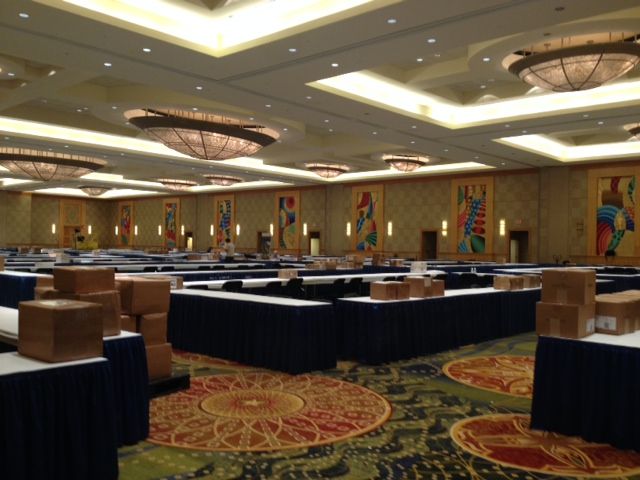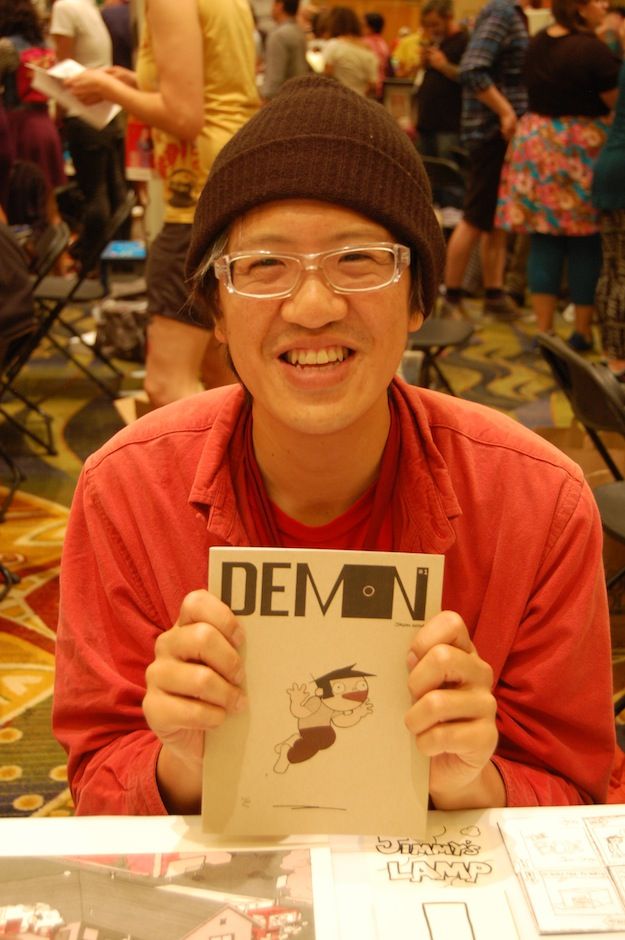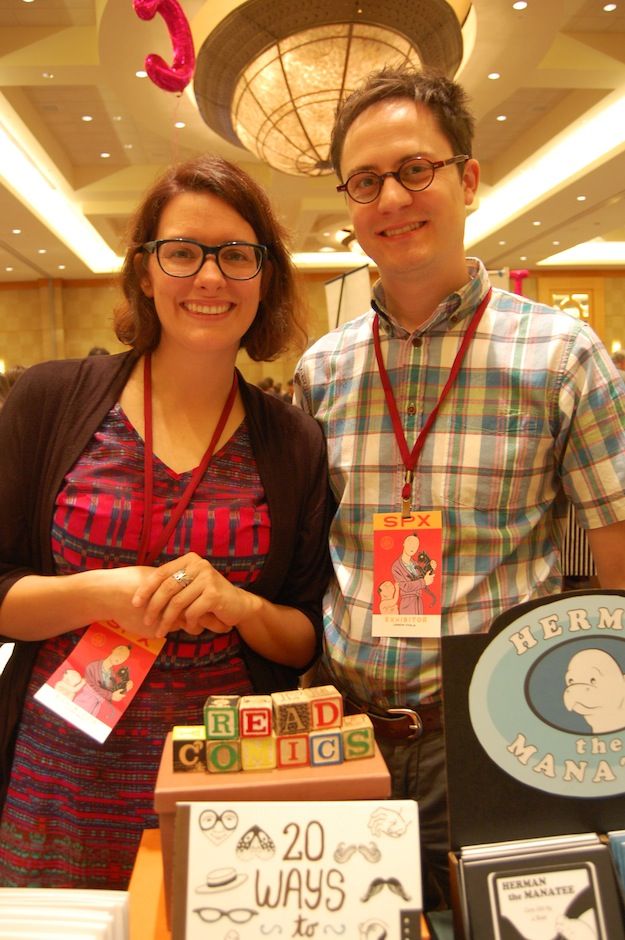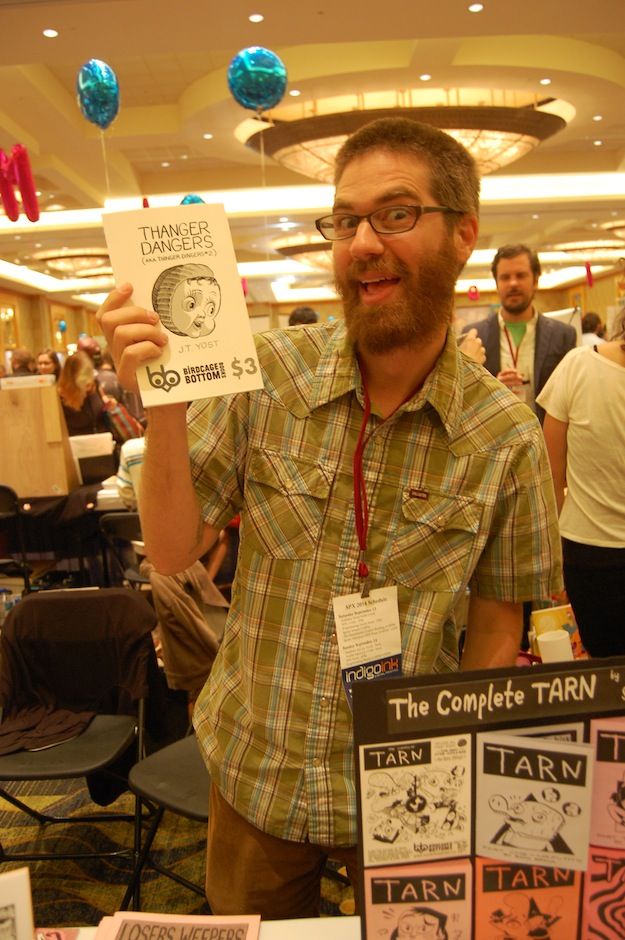As is usually the case, the 2014 Small Press Expo was a whirlwind affair, full of panels, hurried greetings, bumping into people while walking along the aisles and comics, comics, comics everywhere you looked.
Both Brigid Alverson and I were there, although we never actually managed to meet up (while SPX isn't a large show by national standards, it's still easy to miss people). Rather than write separate stories, we thought it might be fun to post a back-and-forth dialogue, similar to our MoCCA report from a few years back. Be sure also to check out Brigid's great photos from the Ignatz Awards if you haven't already done so.
Chris Mautner: How many times have you been to SPX before this, Brigid? What’s your previous experience with this particular convention been like?
Brigid Alverson: This was actually my first SPX, which surprised a lot of people — clearly this is a show that you come back to over and over. I have been going to MoCCA and TCAF for the past couple of years, so I’m familiar with a lot of the artists and the work. I felt there was more commingling at SPX, partly because everyone is staying in the same hotel where the show is, and also because the organizers made the effort — there was a meet-'n'-greet for exhibitors and press the evening before the show, and the Ignatz Awards/mock wedding on Saturday. Maybe because of that, I really got a sense of community from this show.
And while I know it’s obvious from the name, I have to say I was impressed by the small presses and “micropublishers” who were there. The quality of the comics was high, and the publishers were really doing a good job of promoting them. I’m more accustomed to seeing individual creators at these shows, and while some are great at presenting their work, others are not. The publishers uniformly did a good job, and I got turned on to a lot of great new comics as a result.
As someone who has obviously been to more than one SPX, what did you think? How did this year’s show compare to previous years?
Chris: As you noted, I’ve been going off and on to SPX for a long time, and the show has snapped into a set rhythm for me: Walk the aisles, get that one book that you’ve been itching for, say hello to cartoonists and fellow bloggers you bump into, attend a panel, etc. There’s a certain familiarity and ritualistic nature to the show that I do enjoy.
For a variety of reasons, I opted to just visit the show on Saturday, instead of staying overnight, as I have been for the past few years. That gave me a somewhat-truncated view of the show, but I did come with a couple of takeaways.
Last year, of course, was the year that the organizers opted to expand the show to cover the entire ballroom, after the problems they had with registration. I remember being amazed at how many tables there were when I first entered the room and wondering if they could maintain that size in the future. More tables meant less money to be spread around, after all.
Obviously they decided to not only keep the current room size but added (if my sources are correct) even more tables. As a result, more than ever this year I felt a little at sea. There was just so much stuff!
While the show floor never seemed empty, and there was a nicely sized throng throughout the day, the crowd seemed to come in waves. When I got there at 11:30 a.m. Saturday, it seemed packed, then it seemed to thin out a little, then swarmed again after lunch. Some of the exhibitors I talked to corroborated this, saying they would get mobbed and then it would be dead for a while.
I saw more shopper-less tables than ever this year. You get that with every con -- folks staring at you with pleading eyes while you walk by -- but it seemed at times like there were three empty tables to one packed with fans. That suggests to me that either a) attendance wasn’t as strong this year (the rain could have kept some people away); b) people didn’t have as much money to spread around; c) shoppers were looking to spend at very specific places and not interested in trying new things. This could all be completely erroneous assumptions on my part, but I do worry that SPX has plateaued.
Does this jibe with your own experiences? What was it like on Sunday?
Brigid: You know, Paul Karasik actually addressed this at the Ignatz Awards: He gave the audience an “assignment,” to go visit a table where there were no customers, and to move out of their comfort zone a bit. Maybe he had an effect, because it seemed like there were fewer tables on Sunday that weren’t doing business. That might also be because some people had just about sold out of their stock by then. And of course, the weather was better.
Chris: It’s good to hear that people were selling out of their stock; that encourages me. I know by the end of the day Saturday, it looked like Fantagraphics would be sold out of copies of Megahex early Sunday morning. Usually with SPX (and similar shows) there’s discussion about what the “book of the show” is -- that one book that everyone is talking about or carrying under their arms. I didn’t get a feel there was any one “must have” book this year though, did you? Megahex certainly seemed like a contender, as did Sugar Skull, the third volume in Charles Burns’ trilogy. What books did you hear people buzzing about?
Brigid: I can’t say there was any one book that everyone was talking about, but there were a few that came up more than once. One was not actually at the show: Beauty, by the Miss Don’t Touch Me team of Kerascoet and Hubert; NBM was supposed to be debuting it, but the copies didn’t arrive in time. That was a shame, as it seems like a lot of people were looking forward to it.
It’s not really a book of the show, but I was part of a lively conversation about Fukitor, one of the inaugural releases from Fantagraphics’ FU imprint. The book sparked a debate last year when Frank Santoro (who was part of this conversation) showed a few pages at The Comics Journal blog, and while I haven’t read it, I think the general point is an interesting: Are there any boundaries, and is it OK to be offensive in the service of art?
I roomed with Johanna Draper Carlson on Saturday, and we each turned the other on to a minicomic that we made a return trip to the floor to get: Johanna sold me on On the Books, a graphic novel about working at the Strand Bookstore in New York in 2012, when the staff was trying to unionize. I used to live near the Strand, and I wouldn’t be surprised if some of the books I sold them when I moved away in 1989 are still in a back room somewhere. I introduced Johanna to the work of Jason Viola and Cara Bean, two Massachusetts minicomics creators, and she picked up their SPX debut book Heart Farts, which is a collaboration between the two of them and Jason’s wife, Rebecca.
What interesting books did you find, Chris?
Chris: I have a confession to make: I bought Fukitor. I apologize in advance to all, but my curiosity was high and I felt like I had to see for myself just how awful this book actually was, in the same way my daughter touched a burning-hot Pyrex dish once immediately after her mother said, “Don’t touch that, it’s hot.” Like you, I’m intrigued by the idea of transgressive art and when is it worthy of acclaim and when is it just empty yelling, and can a work contain racist and/or misogynist content and still be worthy of discussion if not necessarily actual merit? I might end up with a severe case of buyers’ remorse once I actually sit down to read it (especially considering the $30 price tag), but I’m crossing my fingers for now.
I also picked up The Cage by Martin Vaughn-James, a book I’ve been hearing a lot about lately. To describe the comic (originally published in 1975!) would be difficult, it’s more of a dream-narrative that transverses back and forth through time in a series of seemingly empty buildings. Think Myst by way of David Lynch and you have an inkling of what this is about.
Let’s see, what else? Ryan Cecil Smith had a great, super-tiny, DayGlo sci-fi mini that might be my favorite thing I picked up at the show. I picked up a bunch of Michael DeForge’s latest, including the new Lose. And the latest issue of Studygroup magazine looks fantastic – I can’t wait to dive in (in 3D, no less).
Did you see the Fremok table? They had a ton of great avant-garde European comics for sale at reasonable prices. I had to watch my wallet, but I did pick up the latest Cowboy Henk book, a rather sardonic and surreal trip through Belgium’s history.
Did you get to check out any panels during the show?
Brigid: I did! The panel lineup was great, and I wish I could have gone to more. The first panel was about cartooning for alt-weekly newspapers, and it featured Jules Feiffer, Lynda Barry, Charles Burns, Tom Tomorrow and Ben Katchor, and it was hosted by James Sturm. It was a lively discussion, and Barry was particularly funny -- I’d say a good rule of thumb is, if there’s a Lynda Barry panel, go to it!
Immediately after that was Raina Telgemeier’s panel, and it was interesting to see a mix of children and adults in the audience, including some kids who were true fans. She really engaged the audience and finished up the panel by drawing an improv comic with suggestions from the crowd. And then I was on the panel on getting your comic reviewed, which was moderated by Johanna Draper Carlson. I think we gave the audience a lot of tough love with that one, and I hope someone was recording it so others can see it as well.
I would have loved to go to the panel on micropublishing, but at that point I had been sitting still for three hours and was anxious to get to the show floor. Fortunately, Zachary Clemente wrote it up for The Beat.
Did you make it to any panels?
Chris: Yup! I went to the panel on Fremok on Saturday, where Yvan Algabe and Dominic Goblet talked in detail about how their publishing company grew out of the indie comic art scene in Europe in the 1990s. I found it very enlightening despite some (minor) language barrier issues. I was especially interested in hearing how they initially got started wanting to find a space between pure illustration and comics.
I also went to the Inkstuds panel with Michael DeForge, Patrick Kyle, Brandon Graham, Robin McConnell and Simon Hanselmann. It was a bit of a shambles -- Hanselmann was late to the panel, and I got the feeling there was a general lack of organization on everyone's part. Despite that, it was very entertaining, mainly because Hanselmann and Graham are so gregarious and witty.
In fact, while Megahex might not have been the book of the show, Hanselmann was almost certainly the belle of the SPX ball. Not just with his “wedding,” but wandering around the show floor and signing books, Hanselmann seemed to be a constant presence. I kept bumping into him, at any rate, and was thoroughly charmed by his good humor.
So, to sum up, how does SPX rate in your opinion? Would you go back next year?
Brigid: Absolutely! I’ll always love San Diego and New York Comic Con, but these small-press and indie-comics shows are my favorites. They offer a really satisfying mix of well-known and emerging creators, and the creators tend to be more accessible. SPX in particular was very well run and comfortable -- I’m old enough that I don’t enjoy roughing it any more, so it was nice to stay in a comfortable hotel and have everything right there. Plus, so many interesting comics! With the end of con season coming on, I’m storing away things to write about for the long winter ahead, and SPX has given me plenty of material.






